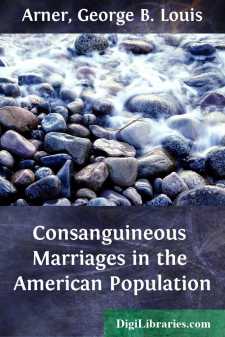Categories
- Antiques & Collectibles 13
- Architecture 36
- Art 48
- Bibles 22
- Biography & Autobiography 813
- Body, Mind & Spirit 142
- Business & Economics 28
- Children's Books 15
- Children's Fiction 12
- Computers 4
- Cooking 94
- Crafts & Hobbies 4
- Drama 346
- Education 46
- Family & Relationships 57
- Fiction 11829
- Games 19
- Gardening 17
- Health & Fitness 34
- History 1377
- House & Home 1
- Humor 147
- Juvenile Fiction 1873
- Juvenile Nonfiction 202
- Language Arts & Disciplines 88
- Law 16
- Literary Collections 686
- Literary Criticism 179
- Mathematics 13
- Medical 41
- Music 40
- Nature 179
- Non-Classifiable 1768
- Performing Arts 7
- Periodicals 1453
- Philosophy 64
- Photography 2
- Poetry 896
- Political Science 203
- Psychology 42
- Reference 154
- Religion 513
- Science 126
- Self-Help 84
- Social Science 81
- Sports & Recreation 34
- Study Aids 3
- Technology & Engineering 59
- Transportation 23
- Travel 463
- True Crime 29
Consanguineous Marriages in the American Population
Description:
Excerpt
CHAPTER I
INTRODUCTION
The purpose of this essay is to present in a concise form and without bias or prejudice, the most important facts in regard to consanguineous marriages, their effects upon society, and more particularly their bearing upon American social evolution. The problems to be considered are not only those which relate primarily to the individual and secondarily to the race, such as the supposed effect of blood relationship in the parents upon the health and condition of the offspring; but also the effect, if any, which such marriages have upon the birth-rate, upon the proportion of the sexes at birth, and the most fundamental problem of all, the relative frequency with which consanguineous marriages take place in a given community.
No thorough and systematic study of the subject has ever been made, and could not be made except through the agency of the census. The statistical material here brought together is fragmentary and not entirely satisfactory, but it is sufficient upon which to base some generalizations of scientific value. The sources of these data are largely American. Little attempt is made to study European material, or to discuss phases of the problem which are only of local concern. Some topics, therefore, which have frequently been treated in connection with the general subject of consanguineous marriages are here ignored as having no scientific interest, as for instance that of the so-called "marriages of affinity," which has been so warmly debated for the past fifty years in the British Parliament.
For obvious reasons it will often be impossible to distinguish between the different degrees of consanguinity, but wherever possible the degree will be specified. It is probable that where a number of marriages are vaguely given as consanguineous, few are more distant than second cousins, for in the United States especially, distant relationships are rarely traced except by genealogists. In designating degrees of relationship the common terminology will be used, as in the following table, expressing, however, the rather clumsy expression, "first cousin once removed" by the simpler form "1-1/2 cousin."
By far the greater part of the literature of consanguineous marriage is of a controversial rather than of a scientific nature, and a search for statistical evidence for either side of the discussion reveals surprisingly little that is worthy of the name. Yet men of high scientific standing have repeatedly made most dogmatic assertions in regard to the results of such unions, and have apparently assumed that no proof was necessary. For example, Sir Henry Sumner Maine "cannot see why the men who discovered the use of fire, and selected the wild forms of certain animals for domestication and of vegetables for cultivation, should not find out that children of unsound constitution were born of nearly related parents."
Much space is given to the alleged "innate horror of incest," and frequent appeals are made to Scripture, wrongly assuming that the marriage of cousins is prohibited in the Mosaic Law.
The origin of "prohibited degrees" is only conjectural. The Christian Church apparently borrowed its prohibitory canons from the Roman Law, and a dispensation is still necessary before a Catholic can marry his first cousin. However, such dispensations have always been easy to obtain, especially by royal families, and even the marriage of uncle and niece sometimes occurs, as among the Spanish Habsburgs, and as recently as 1889 in the House of Savoy.
The prohibition of the marriage of first cousins was removed in England by the Marriage Act of 1540, but by this time the idea of the harmfulness of kinship marriage was so thoroughly impressed upon the people that they were very prone to look askance at such unions, and if they were followed by any defective progeny, the fact would be noted, and looked upon as a chastisement visited upon the parents for their sin. Naturally the idea became proverbial, and in some places it has influenced the civil law.
Perhaps the first printed discussion of the subject in America is from the pen of Noah Webster, in an essay which should be as interesting to the spelling reformer as to the sociologist. He writes: "It iz no crime for brothers and sisters to intermarry, except the fatal consequences to society; for were it generally practised, men would become a race of pigmies. It iz no crime for brothers' and sisters' children to intermarry, and this iz often practised; but such near blood connections often produce imperfect children....


